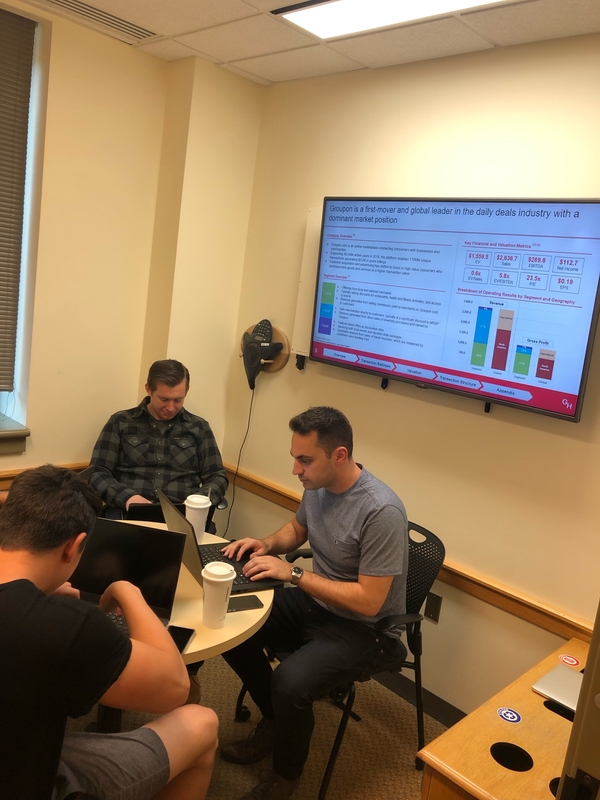Grubhub and Groupon: What if they merged?

By Bryan Burroughs, Two-Year MBA ’20
What are the secrets behind a successful business acquisition? How do you formulate an impressive plan for blending two companies? Those were the questions my classmates and I were tasked with answering for an interesting assignment: evaluate and advise Grubhub on potentially acquiring Groupon.
The project was part of our Investment Banking Immersion (IBI), directed by Drew Pascarella, Rempe Wilson Distinguished Lecturer and senior lecturer of finance. Being our first experience with full mergers and acquisitions (M&A) models, one thing was for certain: this assignment would take us outside of our comfort zone.
Company research never tasted so good
Our team determined that the first step of the project was conducting company research: downloading both companies’ mobile apps and ordering food from Grubhub This idea was inspired by the story of a Morgan Stanley investment banker who drove Uber for years, an experience that helped him win the rights to advise Uber on its recent IPO.
After dumplings and sesame chicken, it was time to dig through the financials and company history. Much to our surprise, Grubhub and Groupon had some very similar characteristics and could realize significant cost savings in terms of marketing and technology expenses. Only one question remained: How do we combine a food delivery company with a discount online retailer and coupon seller?

Grubhub and Groupon: A closer look
Grubhub is the domestic leader in the on-demand food delivery industry, boasting its Grubhub and Seamless brands, as well as other tuck-in acquisitions that dominate within their local markets. However, the company has been unable to stave off recent competition and is currently embattled in a fight for market share with Uber’s new food delivery platform, UberEats.
Groupon has traditionally been an online marketplace, selling discounts and coupons to restaurants, local events, and fitness activities. To stretch growth, it added a discount merchandising business that sells a variety of out-of-season goods at less than half their original MRSP. The merchandising business requires significant cash investment in order to hold inventory, which has eroded profits in recent years. Groupon’s stock has been on the decline since its IPO in 2011, losing almost 90 percent of its value.
Can you construct a deal so that both companies benefit?
Through our research, my team determined that the Grubhub’s decision to acquire Groupon is a sound one, given the fact that the latter has three times the customer base and an international business that would allow the former to expand beyond its current domestic offerings. Additionally, the two companies both incur significant marketing and technology costs that could be eliminated if they opted to operate on one platform.
We also saw potential for strategic partnerships between Grubhub’s and Groupon’s restaurant relationships. For example, as another group pointed out, Grubhub could sell Groupon discounts to consumers as they were ordering food. This would generate more revenue for the combined company and save customers money—always a win-win!

Our group’s recommendation to Grubhub was the following: offer a 20 percent premium on Groupon’s current stock price, with an exchange of Groupon shares for Grubhub shares upon deal closing. Given the current trading premium of Grubhub’s stock, the deal would be immediately accretive, a term for when earnings per share increase for the new company after an M&A transaction occurs.
Our biggest concern was whether or not Groupon shareholders would agree with the strategy. The company’s founder still owns 14 percent of the shares and most shareholders purchased the stock at a higher price than my group’s offer price. Fortunately, our concerns were alleviated after discussing that an equity deal would provide a potential upside for all the current investors in that each would have shares in a more successful combined company.
Assessments from alumni in the industry
As all the IBI groups prepared to step into the pitch room and present their transactions, there was a lot of anxiety, even though we felt ready. When it was finally time for our time in the pitch room, we were caught off guard when we were greeted by a surprise audience of three alumni, all of whom work are current vice presidents at firms such as Bank of America and Moelis & Company. They were more than sitting in on our presentations; They were there to evaluate our work and provide feedback.
Presenting to successful Wall Street bankers was a learning opportunity in and of itself for everybody in the room. Drew Pascarella and the alumni peppered groups with questions, focusing on synergies, how the two companies align, and pricing of the transaction. Most of the insights presented were more or less similar to ours, as this transaction had some very good upsides but at the same time some very bad downsides.
After a few groups presented, it was time to hear assessments of the deal from. Interestingly, they did not recommend this transaction to occur. Although there were a significant number of cost savings to be had, the alumni did not feel the customer bases aligned well enough with one another.
Overall, the assignment was a great experience. From the start of the project to final presentations, it’s clear that my classmates and I have gained a lot from the IBI program, having learned lessons now that will enable us to succeed later in our careers. When we look back on this experience, I’m confident my classmates and I will all agree that IBI made us better.
About Bryan Burroughs, Two-Year MBA ’20

Bryan is a first-year MBA candidate at Johnson and will be working at Goldman Sachs in the industrials investment banking group this summer. Before business school, he worked at Textron Inc., an industrial conglomerate focused in aerospace and defense. At Textron, Bryan held numerous positions within the finance organization and was a graduate of Textron’s leadership development program. Bryan holds a BS in accounting and finance from the University of Maryland.
